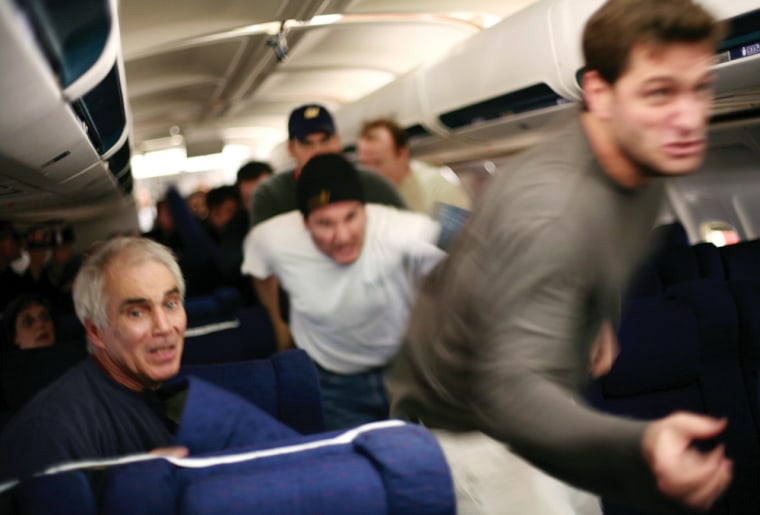When the producers of “United 93” went ahead with their plans to create a fictional account of the one flight on 9/11 that did not reach its target because of a heroic uprising by passengers, they must have channeled the anxiety of the filmmakers behind such raw and emotional cinematic experiences as “The Diary of Anne Frank” in 1959, “Judgment at Nuremberg” in 1961,“Coming Home” and “The Deer Hunter” in 1978.
Although there were a handful of others before it that escaped widespread notice, “The Diary of Anne Frank” is considered the first feature film released to a mainstream audience that confronted the horrors of the Holocaust — and it came 14 years after the end of World War II. Two years later, “Judgment at Nuremberg” contributed to an international dialogue about the Holocaust with shattering newsreel footage interspersed with the dramatization of the American tribunal that brought four Nazi judges to trial.
“Coming Home” and “The Deer Hunter” also were not the first pictures to open the wounds of Vietnam, but they were the first major releases from Hollywood and they began a wave that included “Apocalypse Now” (1979), “Platoon” (1986) and “Full Metal Jacket” (1987).
The “United 93” filmmakers faced a similarly daunting challenge to their predecessors who worked on those groundbreaking movies, all of which won Academy Awards. But “United 93” might be the most daring of them all, considering the relatively short amount of time between the event itself and the release of the film.
Director Paul Greengrass and his collaborators have set a very high bar for any 9/11-themed films that follow, while at the same time they’ve softened a reluctant moviegoing populace through creativity, sensitivity and respect. Because “United 93” grapples with an traumatic event in a truthful manner, the film should make it easier for pictures like Oliver Stone’s “World Trade Center,” due out in August, to attract audiences.
But Stone may face a problem that Greengrass was wise to avoid. “World Trade Center,” which tells the story of the last two survivors of Ground Zero and their rescuers, will feature recognizable actors like Nicolas Cage, Maggie Gyllenhaal and Maria Bello. Many of the roles in “United 93” were given to real pilots and real flight attendants, as well as to some of the actual air traffic controllers who worked on 9/11.
Greengrass may have felt duty-bound to cast his movie that way, again because there are still open wounds regarding that hellish day and any suggestion of Hollywood celebrity or commercialism might have tainted the project. Having a famous actor with extensive credits like Ed Harris play Ben Sliney, the FAA’s operations manager, instead of Sliney himself might have put distance between the audience and the story. The approach Greengrass took eliminated that distance; in its place is a shared experience.
The aforementioned Holocaust and Vietnam films did not face the “too soon” problem. Then again, when is too soon? Even Steven Spielberg’s “Schindler’s List,” released in 1993, and later Roman Polanski’s “The Pianist” in 2002 offered brutal and horrifying depictions of the Holocaust that weren’t easier to endure simply because a considerable amount of time had passed.
It may be that proximity plays a more prominent role in the issue of whether films like “United 93,” “World Trade Center” and the certain stream of followers to come are easily accepted in the United States.
The magnitude of the Holocaust is almost indescribable, yet it happened in faraway Europe, and initially what Americans saw of it came primarily from newsreels and radio reports. Vietnam took place half a world away.
The problem of proximitySeptember 11 happened on our shores, in New York City, Washington, D.C. and Pennsylvania, involving iconic landmarks. And we watched it unfold in our living rooms. Therefore, it hit home. It happened to us.
The result is an unprecedented level of hesitancy, manifested in some recent and much-publicized complaints from moviegoers at some theaters about being subjected to the trailer for “United 93.” Those reports should fade away quickly once buzz builds about the film.
Historically, Hollywood has told difficult stories through the eyes of particular characters from particular points of view. There was Anne Frank, of course, along with Adrien Brody’s character in “The Pianist,” Liam Neeson’s Oskar Schindler, Robert DeNiro’s character in “The Deer Hunter” and Jane Fonda’s in “Coming Home.” That is done by design, in a traditional effort to connect audiences to people and events on the screen.
But Greengrass defied the Hollywood formula, to great effect. The event and the experience are the main characters. Certainly there will be films to follow, starting with “World Trade Center,” that focus on individuals. Since “United 93” is the initial foray into this topic, it’s probably better that Greengrass told it from multiple points of view so as not to value one person’s life or experiences on that day over another’s.
Before embarking on this project, Greengrass met with the families of the victims to ease their concerns and assure them that he would treat the story of United flight 93 with dignity and respect. As time goes by, filmmakers may feel more artistic freedom to explore the multitude of storylines that emerged from that single day. Families may feel less protective and audiences may be more receptive as Americans ease slowly into a period of post-9/11 reflection and examination.
Moviegoers are accustomed to facing their fears because Hollywood has prepared them over the years with numerous interpretations of history’s darkest hours. Even though the pain from 9/11 lingers fresh, this is just another, with many more to come.
Michael Ventre is a frequent contributor to MSNBC.com.
